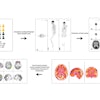AI software for detecting large vessel occlusions on CT can shave critical minutes from thrombectomy procedures for stroke patients, according to a study published September 18 in JAMA Neurology.
In a clinical trial in 243 patients, a group at UTHealth in Houston, Texas, tested whether the AI software coupled with secure group messaging among clinicians and radiologists could improve in-hospital thrombectomy workflows. The approach reduced the time it takes to perform thrombectomies by 11 minutes, they found.
"The benefit of endovascular stroke therapy in large vessel occlusion (LVO) ischemic stroke is highly time dependent. Process improvements to accelerate in-hospital workflows are critical," wrote lead author Juan Carlos Martinez-Gutierrez, MD, and colleagues.
Endovascular thrombectomy (EVT) is a type of minimally invasive endovascular therapy in which interventional radiologists or neurointerventionists remove blood clots (occlusions) from the brain after patients experience an ischemic stroke. This restores blood flow and reduces damage to brain tissue, with studies showing that quicker treatment times result in better outcomes for patients.
To test whether deploying AI (Viz LVO, Viz.ai) can speed up treatment times for these patients, the researchers deployed the software at four comprehensive stroke centers in Houston area. They analyzed results in 243 patients with LVO who underwent thrombectomies between January 2021 and February 2022.
All patients underwent imaging with noncontrast head CT, followed immediately by CT angiograms (CTAs), with the AI software included in the analysis in 103 cases.
The AI software pushed alerts to a mobile phone application, which the clinical care team was required to download onto their phones. Within the application, a mobile PACS allowed users to verify imaging findings, while a secure messaging platform allowed the entire care team to communicate.
According to the results, this workflow approach reduced door-to-procedure time (the time from when a patient arrives at the hospital to when the interventional radiologist accesses the groin artery) by 11.2 minutes. In addition, the overall time from the CT scans to the start of thrombectomy procedures fell by 9.8 minutes.
However, the researchers did not observe significant differences in hospital length of stay, discharge, or 90-day functional outcomes, they noted.
"Automated LVO detection coupled with secure mobile phone application-based communication improved in-hospital acute ischemic stroke workflows," the researchers wrote.
Ultimately, the process for screening, evaluating, and treating stroke patients with EVT can be highly complicated, with many different care teams required to work in synchrony, the authors wrote.
Importantly, they highlighted that the automated LVO push alert arrived within minutes of CTA completion, far earlier than human interpretation, and in many cases, even before the CTA images were available for review on the clinical PACS.
"Software implementation was associated with clinically meaningful reductions in EVT treatment times," the group concluded.
The full article is available here.




















